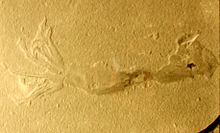m [T6/r81] Adding authority information. |
Mgiganteus1 (talk | contribs) rv; linked authority already included |
||
| Line 21: | Line 21: | ||
* (uncertain order) |
* (uncertain order) |
||
** †[[Ostenoteuthidae]] |
** †[[Ostenoteuthidae]] |
||
}} |
|||
| authority = Bather, 1888}} |
|||
[[Subclass (biology)|Subclass]] '''Coleoidea''',<ref>From Greek ''keleos'', sheath</ref><ref name=Cephalopods>{{cite book|isbn=0-19-852761-6|author=Marion Nixon and J.Z. Young.|year=2003|publisher=Oxford University Press|location=New York|title=The brains and lives of cephalopods}}</ref> or '''Dibranchiata''', is the grouping of [[cephalopod]]s containing all the primarily [[Soft-bodied organisms|soft-bodied creatures]]. Unlike its sister group [[Nautiloidea]], whose members have a rigid outer shell for protection, the '''coleoids''' have at most an internal bone or shell that is used for buoyancy or support. Some species have lost their bone altogether, while in some it has been replaced by a [[cartilage|cartilaginous]] support structure. |
[[Subclass (biology)|Subclass]] '''Coleoidea''',<ref>From Greek ''keleos'', sheath</ref><ref name=Cephalopods>{{cite book|isbn=0-19-852761-6|author=Marion Nixon and J.Z. Young.|year=2003|publisher=Oxford University Press|location=New York|title=The brains and lives of cephalopods}}</ref> or '''Dibranchiata''', is the grouping of [[cephalopod]]s containing all the primarily [[Soft-bodied organisms|soft-bodied creatures]]. Unlike its sister group [[Nautiloidea]], whose members have a rigid outer shell for protection, the '''coleoids''' have at most an internal bone or shell that is used for buoyancy or support. Some species have lost their bone altogether, while in some it has been replaced by a [[cartilage|cartilaginous]] support structure. |
||
Revision as of 05:30, 12 January 2011
| Coleoidea Temporal range: Devonian or
| |
|---|---|

| |
| Juvenile cephalopod from plankton Antarctica | |
| Scientific classification | |
| Domain: | Eukaryota |
| Kingdom: | Animalia |
| Phylum: | Mollusca |
| Class: | Cephalopoda |
| Clade: | Neocephalopoda |
| Subclass: | Coleoidea Bather, 1888 |
| Orders | |
| |
Subclass Coleoidea,[1][2] or Dibranchiata, is the grouping of cephalopods containing all the primarily soft-bodied creatures. Unlike its sister group Nautiloidea, whose members have a rigid outer shell for protection, the coleoids have at most an internal bone or shell that is used for buoyancy or support. Some species have lost their bone altogether, while in some it has been replaced by a cartilaginous support structure.
The major dividings of Coleoidea are based upon the number of arms or tentacles and their structure. The extinct and most primitive form, the Belemnoidea, presumably had ten equally sized arms, in five pairs numbered dorsal to ventral as I, II, III, IV and V. More modern species either modified or lost a pair of arms. The superorder Decapodiformes has arm pair IV modified into long tentacles with suckers generally only on the club-shaped distal end. Superorder Octopodiformes has modifications to arm pair II; it is significantly reduced and used only as a sensory filament in the Vampyromorphida, while Octopoda species have totally lost that arm pair.
Evolutionary history
The earliest certain coleoids are known from the Mississippian sub-period of the Carboniferous Period, about 330 million years ago. Some older fossils have been described from the Devonian,[3] but paleontologists disagree about whether they are coleoids.[4]
By the Carboniferous, coleoids already had a diversity of forms. Although most of these groups are traditionally classified as belemnoids, the variation among them suggests that some are not closely related to belemnites.[5]
Classification

- Class Cephalopoda
- Subclass Nautiloidea: nautilus
- Subclass †Ammonoidea: ammonites
- Subclass Coleoidea
- Division †Belemnoidea: extinct belemnoids
- Genus †Jeletzkya
- Order †Hematitida
- Order †Phragmoteuthida
- Order †Donovaniconida
- Order †Aulacocerida
- Order †Belemnitida
- Division Neocoleoidea
- Superorder Decapodiformes
- ?Order †Boletzkyida
- Order Spirulida: Ram's Horn Squid
- Order Sepiida: cuttlefish
- Order Sepiolida: bobtail squid
- Order Teuthida: squid
- Superorder Octopodiformes
- Family †Trachyteuthididae (incertae sedis)
- Order Vampyromorphida: Vampire Squid
- Order Octopoda: octopus
- Superorder Decapodiformes
- Division †Belemnoidea: extinct belemnoids
- (uncertain order)
- family †Ostenoteuthidae[6]
References
- ^ From Greek keleos, sheath
- ^ Marion Nixon and J.Z. Young. (2003). The brains and lives of cephalopods. New York: Oxford University Press. ISBN 0-19-852761-6.
- ^
Bandel, Klaus, Reitner, J., & Sturmer, W. (1983). "Coleoidea from the Lower Devonian Black Slate ("Hunsruck-Schiefer")". Neues Jahrbuch für Geologie und Paläontologie, Abhandlungen. 165 (3). Stuttgart: 397–417.
{{cite journal}}: CS1 maint: multiple names: authors list (link) - ^
Nishiguchi, Michelle, & Mapes, Royal K. (2008). "Cephalopoda". Phylogeny and evolution of the Mollusca. Dordrecht, The Netherlands: Springer. pp. 163–199. ISBN 978-0520250925.
{{cite book}}: Unknown parameter|editors=ignored (|editor=suggested) (help)CS1 maint: multiple names: authors list (link) - ^
Doguzhaeva, Larisa A., Mapes, Royal H., & Mutvei, Harry (2007). "Cephalopods Present & Past: New Insights and Fresh Perspectives" (Document). Berkeley & Los Angeles, California, USA: University of California Press. pp. 121–143.
{{cite document}}: Unknown parameter|contribution=ignored (help); Unknown parameter|editors=ignored (help)CS1 maint: multiple names: authors list (link) - ^ Garassino A. & Donovan D. T. (2000). "A New Family Of Coleoids From The Lower Jurassic Of Osteno, Northern Italy". Palaeontology 43(6): 1019-1038, 5 plates. PDF
- Bather, F.A. (1888). "Shell-growth in Cephalopoda (Siphonopoda)". Annals and Magazine of Natural History. 6 (1): 298–310.